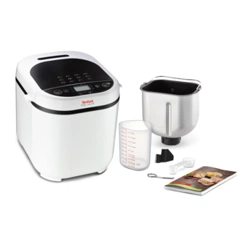Loading ...
Loading ...
Loading ...

102
Yeast: Bread is made using baker's yeast. This type of yeast is sold in
several forms: small cubes of compressed yeast, active dry yeast to be
rehydrated or instant dry yeast. Yeast is sold in supermarkets (bakery or
fresh foods departments), but you can also buy compressed yeast from
your baker.
The yeast must be directly incorporated in your machine's pan with
the other ingredients. Nonetheless consider thoroughly crumbling the
compressed yeast between your fingers to facilitate its dispersion.
Follow the recommended amounts (see the equivalences chart below).
Quantity/weight equivalences between dry yeast and compressed yeast:
Dry yeast (in tsp) 1 1.5 2 2.5 3 3.5 4 4.5 5
Compressed yeast (in g) 9 13 18 22 25 31 36 40 45
Flours: Using T55 flour is recommended, unless otherwise indicated in
the recipes. When using mixes of special flour types for bread, brioche
or milk bread, do not exceed 750 g of dough in total (flour + water).
Depending on the quality of the flour, the bread making results may also
vary.
• Keep flour in a hermetically sealed container, since flour reacts to
fluctuations in climate conditions (humidity). Adding oats, bran, wheat
germ, rye or whole grains to the bread dough, will produce a bread that
is denser and less fluffy.
• The more a flour is based on whole grains, that is, containing a part of
the outer layers of a wheat grain (T>55), the less the dough will rise and
the denser the bread will be.
• You will also find commercially available ready-to-use preparations for
breads. Please refer to the manufacturer's recommendations for the use
of these preparations.
Gluten-free flour: Using large quantities of these flour types to make
bread calls for the use of the gluten-free bread program. There is a large
number of flour types that do not contain any gluten. The best known are
buckwheat flour, rice flour (either white or whole grain), quinoa flour, corn
flour, chestnut flour, millet flour and sorghum flour.
For gluten-free breads, in order to try to recreate the elasticity of gluten,
it is essential to mix several types of non bread making flours and to add
thickening agents.
INFORMATION ON THE INGREDIENTS
Loading ...
Loading ...
Loading ...
